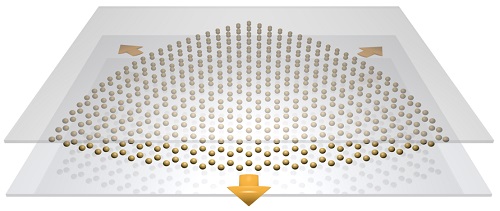
Synthetic Magnetic Field Uses Metasurfaces to Manipulate Photons
EXETER, England, Sept. 17, 2020 — Researchers at the University of Exeter have developed a way to manipulate light with a “synthetic” Lorentz force — which is responsible in nature for a number of phenomena such as the aurora borealis.
The technique allows the researchers to create tunable artificial magnetic fields, enabling photons to mimic the dynamics of charged particles in real magnetic fields. The research may have implications for future photonic devices, as it provides a novel way of manipulating light below the diffraction limit.

Straining a honeycomb metasurface generates an artificial magnetic field for light that can be tuned by embedding the metasurface inside a cavity waveguide. Courtesy of the University of Exeter.
When charged particles, such as electrons, pass through a magnetic field, they feel a Lorentz force — the combination of electric and magnetic forces. This causes the trajectory to curve around the magnetic field lines; it’s responsible for a number of fascinating phenomena, such as the northern lights and the quantum Hall effect.
Because photons don’t carry an electric charge, they can’t be straightforwardly controlled using real magnetic fields.
A 10-year-old discovery — that electrons propagating through a strained graphene membrane behave as if they were subjected to a large magnetic field — inspired the researchers to create artificial magnetic fields for light by distorting honeycomb metasurfaces.
The drawback to the technique is that tuning the field requires precise modification of the strain pattern, an extremely challenging, if not impossible task with photonic structures.
However, the researchers proposed a solution to overcome the lack of tenability.
“These metasurfaces support hybrid light-matter excitations, called polaritons, which are trapped on the metasurface,” said Charlie-Ray Mann, lead scientist and author of the research study. “They are then deflected by the distortions in the metasurface in a similar way to how magnetic fields deflect charged particles. By exploiting the hybrid nature of the polaritons, we show that you can tune the artificial magnetic field by modifying the real electromagnetic environment surrounding the metasurface.”
The researchers embedded the metasurface between two mirrors — known as a photonic cavity — and showed that the magnetic field can be tuned by changing the width of the photonic cavity, thereby removing the need to modify the distortion in the metasurface.
“We have even demonstrated that you can switch off the artificial magnetic field entirely at a critical cavity width, without having to remove the distortion in the metasurface, something that is impossible to do in graphene or any system that emulates graphene,” Mann said.
With that mechanism, he said, the trajectory of the polaritons can be bent using a tunable Laurentz-like force, and also observe Landau quantization of the polariton cyclotron orbits, in direct analogy with what happens to charged particles in real magnetic fields.
“Moreover we have shown that you can drastically reconfigure the polariton Landau level spectrum by simply changing the cavity width,” Mann said.
Eros Mariani, lead supervisor of the study, added, “Being able to emulate phenomena with photons that are usually thought to be exclusive to charged particles is fascinating from a fundamental point of view, but it could also have important implications for photonics applications.”
The research was published in Nature Photonics (www.doi.org/10.1038/s41566-020-0688-8).
Published: September 2020